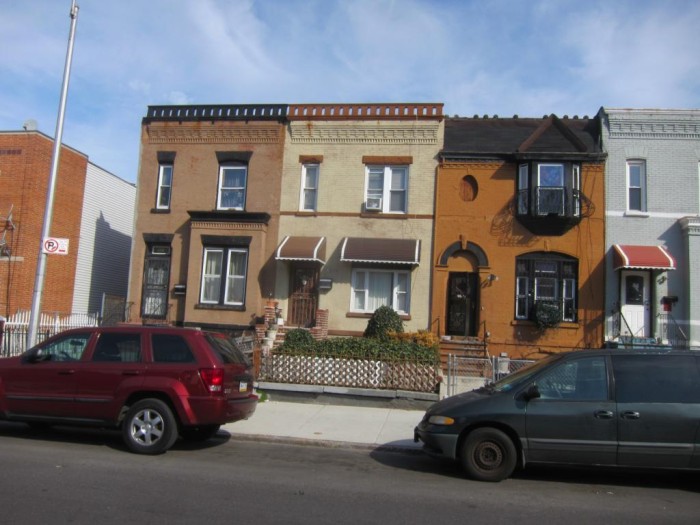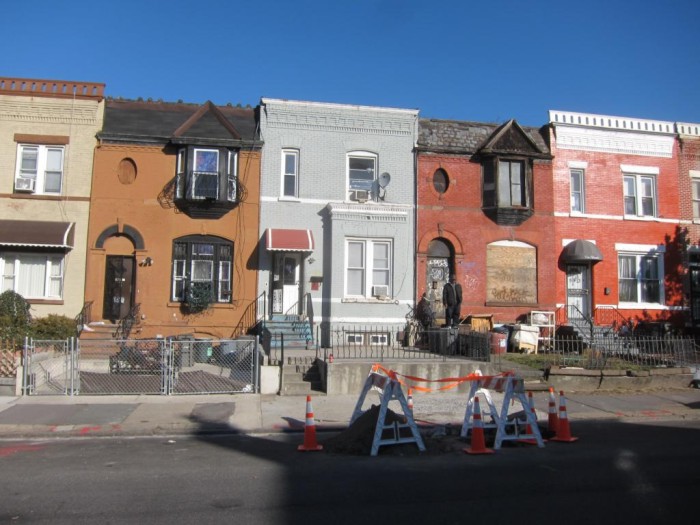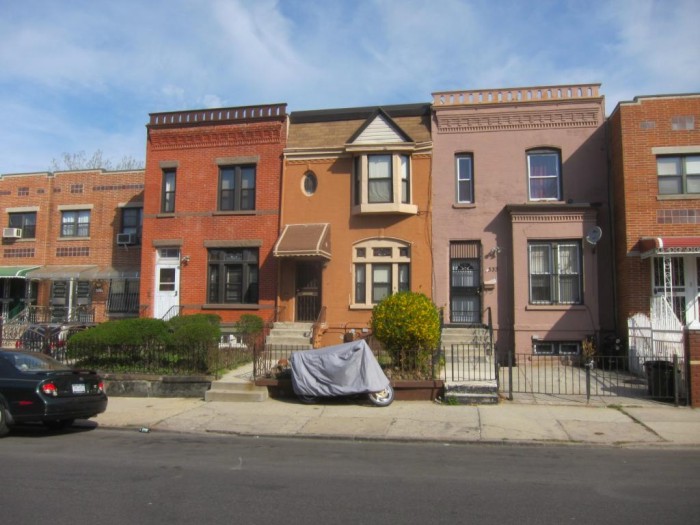Building of the Day: 531-545 Lexington Avenue
Brooklyn, one building at a time. Name: Row Houses Address: 531-545 Lexington Avenue Cross Streets: Throop Avenue and Marcus Garvey Boulevard Neighborhood: Bedford Stuyvesant Year Built: between 1885 and 1888 Architectural Style: Queen Anne Architect: Unknown Landmarked: No The story: This row was once a group of twelve houses. They were built sometime between 1885…


Brooklyn, one building at a time.
Name: Row Houses
Address: 531-545 Lexington Avenue
Cross Streets: Throop Avenue and Marcus Garvey Boulevard
Neighborhood: Bedford Stuyvesant
Year Built: between 1885 and 1888
Architectural Style: Queen Anne
Architect: Unknown
Landmarked: No
The story: This row was once a group of twelve houses. They were built sometime between 1885 and 1888, and by 1888, made up the longest row on the block. For that matter, at the time; they were just about the only houses on this side of the block. They are an attractive and unique group, and were built as single family homes. Remarkably, most of them still are.
In 1885, the elevated train came to this part of Lexington Avenue. It was part of the Brooklyn Rapid Transit Company, and ran from Washington Street near the Brooklyn Bridge, to Broadway and Gates Avenue, where it connected to other lines. The elevated train line here helped spur development of this area, part of the newly established 25th Ward.
Today we regard this general area as a no-man’s land, far from public transportation, but up until October of 1950, when the line was shut down and subsequently demolished, this area was well served with a train that took riders to Jamaica, Queens, East New York, Sands Street in Downtown Brooklyn, or across the river to Park Row in Manhattan.
That was great for the 25th Ward, but not so great for Lexington Avenue. The arrival of the train halted development under the tracks for a long time. But land is valuable, and soon the rest of the block and surrounding areas were developed, as well. These houses were built sometime around when the elevated train began service. They show up on the 1888 map of Brooklyn, pretty much alone on this side of the block.
The elevated line had a station on Sumner Avenue; (now Marcus Garvey) so living here, while noisy and dirty, was certainly convenient. The twelve houses were designed in three different styles. The houses with the cute little oriel on the second floor, and the porthole window and mansard roof were the cutest, but the other two, one with a first floor bay window bump out, the other flat, were certainly handsome as well. The Brooklyn Eagle called them “pretty brick cottages of the Eastlake variety,” in an article about one of the residents in the group.
Those residents were pretty quiet folk for the most part, but one or two houses seemed to attract drama. In 1888, 533 was home to a diamond setter named Augustus Radcliffe. He managed to walk off one day with $6,000 worth of diamonds, while cashing a worthless check for $475 at a local bank. He then disappeared from the face of the earth leaving his wife and children. A check of his finances showed he was in debt for about $50,000. Those were 1888 figures, so he would have stolen about $163,000 worth of diamonds, and been in debt for over $1.2 million dollars. He was in big trouble.
Fortunately for his wife, the house was in her name. When reporters came to visit, she told them he had a gambling problem, and had probably fled to England. Investigators were going to contact the British authorities. When told this news, one of the diamond merchants said he would rather have twenty minutes in a room alone with Radcliffe rather than see him in jail.
Another pretty well off resident of the row was DeWitt Towers, a broker who lived with his wife at 531 Lexington. In 1897, he seemed to go insane after a robbery at his place of business in Manhattan. After the robbery, his personality changed, and he was seen berating and then beating his wife in public. He made the papers after a Good Samaritan tried to stop him from beating his wife in the street. He was jailed and the judge sent him to be evaluated for madness. The papers don’t follow up, but the family was still in the house a few years later, when their Christmas tree caught fire. The fire was put out, but the parlor was damaged.
In 1950, the el tracks came down, exposing Lexington Avenue to the light again. Slowly, very slowly, even after almost 70 years, new life is coming back to this street. These are great houses. They should be at the center of the renewal. Two of the houses are now gone, replaced by modern infill housing. GMAP
Thanks to Morgan Munsey for telling me about this group. What a great find!
(Photo:Nicholas Strini for Property Shark)







A very interesting article about some really notable buildings that deserve recognition.
This article will help document a point that I have long made about the reasons for Lexington Ave’s. stunted development, especially since almost no one remembers the old el. One can only look at how neighboring Quincy St. – especially that wonderful block between Patchen and Ralph – developed at the expense of poor old Lexington. Hopefully, good things will be in store for this street in the future.